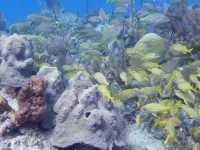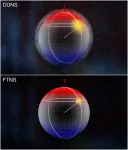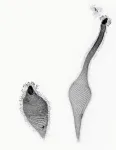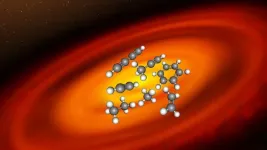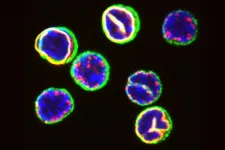(Press-News.org) What species live in this coral reef, and are they healthy? Chemical clues emitted by marine organisms might hold that information. But in underwater environments, invisible compounds create a complex “soup” that is hard for scientists to decipher. Now, researchers in ACS’ Journal of Proteome Research have demonstrated a way to extract and identify these indicator compounds in seawater. They found metabolites previously undetected on reefs, including three that may represent different reef organisms.
Plants and animals living in coral reefs release various substances, from complex macromolecules to individual amino acids, into the surrounding water. To determine which ones could identify the ecosystems’ inhabitants and be used to measure a coral reef’s health, scientists need to prepare water samples for analysis by concentrating the compounds and separating them from the salty broth. They primarily concentrate and collect these dissolved compounds from seawater on sticky membranes. However, this method misses many important nitrogen-, oxygen- and sulfur-containing compounds produced by marine organisms. These metabolites don’t attach well to the membrane materials and are present at extremely low levels in seawater. To overcome these challenges, Brianna Garcia, Amy Apprill, Elizabeth Kujawinski and colleagues at Woods Hole Oceanographic Institution tested a technique that modified the dissolved metabolites before they were extracted from seawater into a form that’s compatible with membrane materials allowing them to be concentrated and analyzed.
First, the researchers collected and filtered water samples from five coral reefs around the U.S. Virgin Islands. They then used a series of reactions to attach a benzoyl functional group to dissolved amine- and alcohol-containing metabolites. Next, the team extracted the modified metabolites from the samples and assessed their composition and concentrations with liquid chromatography-mass spectrometry. From applying this new technique, the researchers identified 23 metabolites that hadn’t been identified near coral reefs by previous studies, including amino acids, amines, pyrimidine nucleosides and organosulfonic acids, which are involved in photosynthesis and organismal growth. When the researchers analyzed their data, they found that:
The presence of diseased coral, macroalgae and crustose coralline algae had the greatest influence on the metabolite compositions.
Some compounds, such as the organosulfonic acid called DHPS, were consistently at high levels in all locations, which suggests the presence of coral and associated organisms.
Three metabolites (homoserine betaine, tryptophan and γ-aminobutryic acid) had significantly different levels among the five reefs, and the researchers attribute those differences to variations in marine environments and organisms.
The researchers say this study successfully demonstrates how to collect previously overlooked, ecologically relevant compounds in coral reef ecosystems that could be used to monitor them for effects from climate change, natural disturbances and disease activity.
The authors acknowledge funding from the National Science Foundation and the National Oceanic & Atmospheric Administration’s Oceanic and Atmospheric Research Cooperative Institutes.
###
The American Chemical Society (ACS) is a nonprofit organization chartered by the U.S. Congress. ACS’ mission is to advance the broader chemistry enterprise and its practitioners for the benefit of Earth and all its people. The Society is a global leader in promoting excellence in science education and providing access to chemistry-related information and research through its multiple research solutions, peer-reviewed journals, scientific conferences, eBooks and weekly news periodical Chemical & Engineering News. ACS journals are among the most cited, most trusted and most read within the scientific literature; however, ACS itself does not conduct chemical research. As a leader in scientific information solutions, its CAS division partners with global innovators to accelerate breakthroughs by curating, connecting and analyzing the world’s scientific knowledge. ACS’ main offices are in Washington, D.C., and Columbus, Ohio.
To automatically receive news releases from the American Chemical Society, contact newsroom@acs.org.
Note: ACS does not conduct research, but publishes and publicizes peer-reviewed scientific studies.
Follow us: X, formerly Twitter | Facebook | LinkedIn | Instagram
END
https://www.scienceopen.com/hosted-document?doi=10.15212/CVIA.2024.0033
Announcing a new article publication for Cardiovascular Innovations and Applications journal. This study was aimed at investigating factors influencing the progression of native coronary atherosclerosis after percutaneous coronary intervention (PCI).
A cohort of 462 patients was classified into progressive (n = 73) or non-progressive (n = 389) groups according to the presence of native coronary atherosclerosis progression on coronary angiography. ...
One of the biggest challenges in quantum technology and quantum sensing is “noise”–seemingly random environmental disturbances that can disrupt the delicate quantum states of qubits, the fundamental units of quantum information. Looking deeper at this issue, JILA Associate Fellow and University of Colorado Boulder Physics Assistant Professor Shuo Sun recently collaborated with Andrés Montoya-Castillo, Assistant Professor of Chemistry, and his team to develop a new method for better understanding and controlling this noise, potentially paving the way for significant advancements in quantum computing, ...
For a tiny hunter of the microbial world that relies on extending its neck up to 30 times its body length to release its deadly attack, intricate origami-like cellular geometry is key. This geometry enables the rapid hyperextensibility of the neck-like protrusion, for single-celled predator Lacrymaria olor, a new study reports. The findings not only explain L. olor’s extreme shape-shifting ability but also hold potential for inspiring innovations in soft-matter engineering or the design of robotic systems. Single-celled protists are well known for their ability to perform dynamic morphological changes in ...
In a Policy Forum, R. Scott Kemp and colleagues argue that promoting new nuclear reactor technologies using high-assay low-enriched uranium (HALEU) threatens the international system of controls that has prevented nuclear weapons proliferation for over 30 years. “Governments and others promoting the use of HALEU have not carefully considered the potential proliferation and terrorism risks that the wide adoption of this fuel creates,” write Kemp et al. The authors warn that if HALEU becomes a standard reactor ...
James Webb Space Telescope (JWST) observations have revealed abundant hydrocarbons in the protoplanetary disk surrounding a young, very-low-mass star – findings that provide novel insights into the chemical environment from which many terrestrial planets, in particular, are born. Planets form in disks of gas and dust that orbit young stars. Observations show that terrestrial planets form more efficiently than gas giant planets around very-low-mass stars (VLMSs) – those with less than 0.3 solar masses. Although the chemical compositions of the inner disk regions around higher mass stars ...
Heat production in fat tissue, a trait also known as adipose tissue thermogenesis, evolved over two stages in mammals, fully developing in eutherian mammals after the group’s evolutionary divergence from marsupials, according to a new study. The results could provide insights that inform future therapies related to metabolism and obesity. Many organisms produce heat internally to regulate body temperature. It is thought that the evolution of the ability to maintain high body temperatures provided ...
“There are some things in life you can watch and then never unwatch,” said Manu Prakash, associate professor of bioengineering at Stanford University, calling up a video of his latest fascination, the single-cell organism Lacrymaria olor, a free-living protist he stumbled upon playing with his paper Foldscope. “It’s … just … it’s mesmerizing.”
“From the minute Manu showed it to me, I have just been transfixed by this cell,” said Eliott Flaum, a graduate student ...
Planets form in disks of gas and dust, orbiting young stars. The MIRI Mid-INfrared Disk Survey (MINDS), led by Thomas Henning from the Max Planck Institute for Astronomy (MPIA) in Heidelberg, Germany, aims to establish a representative disk sample. By exploring their chemistry and physical properties with MIRI (Mid-Infrared Instrument) on board the James Webb Space Telescope (JWST), the collaboration links those disks to the properties of planets potentially forming there. In a new study, a team of researchers ...
From the outside, most T cells look the same: small and spherical. Now, a team of researchers led by Berend Snijder from the Institute of Molecular Systems Biology at ETH Zurich has taken a closer look inside these cells using advanced techniques. Their findings show that the subcellular spatial organisation of cytotoxic T cells – which Snijder refers to as their cellular architecture – has a major influence on their fate.
Characteristics that determine a cell’s fate
When cells with nuclear invaginations encounter a pathogen, they turn into powerful effector cells that rapidly proliferate and kill the pathogen. Their fellow ...
CHAPEL HILL, North Carolina – Researchers at UNC Lineberger Comprehensive Cancer Center and colleagues have established the most comprehensive molecular portrait of the workings of KRAS, a key cancer-causing gene or "oncogene," and how its activities impact pancreatic cancer outcomes. Their findings could help to better inform treatment options for pancreatic cancer, which is the third leading cause of all cancer deaths in the United States.
The research was published as two separate articles in Science.
“Because ...
